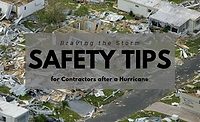Paul Davis Restoration gives consumers storm safety tips
Jacksonville, FL – Spring is
here and with it comes the threat of severe weather. Tornadoes, thunderstorms, hail
storms and flooding can damage or destroy homes and commercial buildings along
with entire neighborhoods within minutes. Paul Davis Restoration, a national
franchise company and leading provider of fire and water damage clean up and restoration services for
residential and commercial properties, provides consumers with a variety of
safety measures that can help to protect yourself and your family when storms
strike.
“Nobody likes to cancel an outdoor activity, but when weather looks threatening, remember to put family safety first. Before heading out, turn on your radio or TV to see if a storm watch or warning is issued for your area. Also, have a family and business disaster plan in place,” said J. “Sonny” Bass, Paul Davis Restoration’s Technical Director of Emergency Services.
A major storm can knock out utility service to your area, leaving you without electricity, heat, water or fresh food. All homes and businesses should have an emergency kit that can be accessed at a moment's notice. An emergency kit should at least include:
Bass also recommends preparing your home for a storm. Below are some valuable tips for helping prevent damage from severe weather. If necessary, hire a professional if you are not equipped to do the work yourself.
If damage to your home or business is significant, contact a professional in the property loss restoration and emergency mitigation service industry. Look for properly licensed companies with certifications from The Institute of Inspection, Cleaning and Restoration Certification (IICRC).
“Taking preventive steps is the key and is well worth it to avoid injury to loved ones and damage to your property from severe storms,” said Bass. “If you're properly prepared, you can react from practice, not panic. You can also greatly increase your chances for weathering the storm safely.”
“Nobody likes to cancel an outdoor activity, but when weather looks threatening, remember to put family safety first. Before heading out, turn on your radio or TV to see if a storm watch or warning is issued for your area. Also, have a family and business disaster plan in place,” said J. “Sonny” Bass, Paul Davis Restoration’s Technical Director of Emergency Services.
A major storm can knock out utility service to your area, leaving you without electricity, heat, water or fresh food. All homes and businesses should have an emergency kit that can be accessed at a moment's notice. An emergency kit should at least include:
- Water – one gallon of water per person per day for at least three days
- Food – at least a three-day supply of non-perishable food
- Battery-powered or hand crank commercial radio and a NOAA Weather Radio and extra batteries for both.
- Cell Phone with charger
- Flashlight and extra batteries
- First aid kit – with sterile dressings; antibiotic ointment; burn ointment; adhesive bandages in a variety of sizes; scissors; eye wash; thermometer (adult and baby); non-prescription drugs such as aspirin or non-aspirin pain reliever; prescription medications; prescribed medical supplies such as glucose and blood pressure monitoring equipment.
- Can opener, garbage bags and plastic ties
- Infant formula and diapers
- Personal and /or feminine supplies
- Pet food and extra water for your pet
- Documents such as copies of insurance policies, identification and bank account records in a waterproof, portable container
- Cash
- Sleeping bag or warm blanket for each person.
- Complete change of clothing including a long sleeved shirt, long pants and sturdy shoes.
- Fire Extinguisher
- Matches in a waterproof container
- Paper cups, plates and plastic utensils, paper towels
- Paper and pencil
- Books, games, puzzles or other activities for children
Bass also recommends preparing your home for a storm. Below are some valuable tips for helping prevent damage from severe weather. If necessary, hire a professional if you are not equipped to do the work yourself.
- Secure major appliances to the walls or countertops of your home using “L” brackets.
- Inspect and make any repairs to your roof to prevent leakage from water driven by high winds. If you have a metal roof, recoat it if needed. If you have a shingle roof, make sure the shingles are secure.
- Remove debris and leaves from your roof. Rotting plant material can deteriorate both shingle and metal roofs.
- Repair exterior siding, awnings, gutters, downspouts and brackets if loose, damaged or dangling. Securely attach your home’s water heater and furnace to wall studs or foundation.
- Learn how to quickly disconnect breakers in the electrical service box, shut off the gas supply and turn off your water from the main shut-off valve.
- Keep your yard free of lawn tools and equipment, garbage cans, bikes, toys and other loose articles.
- Establish a windbreak. Tall, hardwood trees provide a natural windbreak. Remove dead trees.
- Consider replacing older windows with modern, impact-resistant glass.
If damage to your home or business is significant, contact a professional in the property loss restoration and emergency mitigation service industry. Look for properly licensed companies with certifications from The Institute of Inspection, Cleaning and Restoration Certification (IICRC).
“Taking preventive steps is the key and is well worth it to avoid injury to loved ones and damage to your property from severe storms,” said Bass. “If you're properly prepared, you can react from practice, not panic. You can also greatly increase your chances for weathering the storm safely.”
Looking for a reprint of this article?
From high-res PDFs to custom plaques, order your copy today!




